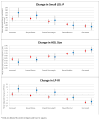Effect of relative weight group change on nuclear magnetic resonance spectroscopy derived lipoprotein particle size and concentrations among adolescents
- PMID: 24508445
- PMCID: PMC3992168
- DOI: 10.1016/j.jpeds.2013.12.029
Effect of relative weight group change on nuclear magnetic resonance spectroscopy derived lipoprotein particle size and concentrations among adolescents
Abstract
Objective: To examine whether longitudinal changes in relative weight category (as indicated by change in body mass index [BMI] classification group) were associated with changes in nuclear magnetic resonance (NMR)-derived lipoprotein particles among US youth.
Study design: Secondary analysis of data from a clustered randomized controlled trial. BMI and fasting blood samples were obtained from 2069 participants at the start of the 6th grade and end of the 8th grade. BMI was categorized as normal weight, overweight, or obese at both time points. Lipoprotein particle profiles were measured with NMR spectroscopy at both time points. Regression models were used to examine changes in relative weight group and change in lipoprotein variables.
Results: A total of 38% of participants changed relative weight category (BMI group) during the 2.5-year study period. Low-density lipoprotein (LDL) cholesterol and non-high-density lipoprotein (HDL) cholesterol decreased almost universally, but more with improved BMI category. There were adverse effects on LDL size and total LDL particles, HDL size, and cholesterol for participants who remained obese or whose relative weight group worsened. Changes in relative category had no impact on HDL particles.
Conclusion: Improvement in relative weight group from 6th to 8th grade was associated with favorable changes in non-HDL cholesterol, very low-density lipoprotein size, LDL size, HDL size, and LDL particles but had no effect on HDL particles. Findings indicate that an improvement in relative weight group between 6th and 8th grade had an effect on NMR-derived particles sizes and concentrations among a large group of adolescents, which overrepresented low-income minorities.
Copyright © 2014 Elsevier Inc. All rights reserved.
Conflict of interest statement
The other authors declare no conflicts of interest.
Figures
References
-
- Laakso M, Sarlund H, Mykkanen L. Insulin resistance is associated with lipid and lipoprotein abnormalities in subjects with varying degrees of glucose tolerance. Arteriosclerosis. 1990;10(2):223–31. - PubMed
-
- Kathiresan S, Otvos JD, Sullivan LM, Keyes MJ, Schaefer EJ, Wilson PW, et al. Increased small low-density lipoprotein particle number: a prominent feature of the metabolic syndrome in the Framingham Heart Study. Circulation. 2006;113(1):20–9. - PubMed
-
- Kuller L, Arnold A, Tracy R, Otvos J, Burke G, Psaty B, et al. Nuclear magnetic resonance spectroscopy of lipoproteins and risk of coronary heart disease in the cardiovascular health study. Arterioscler Thromb Vasc Biol. 2002;22(7):1175–80. - PubMed
Publication types
MeSH terms
Substances
Grants and funding
LinkOut - more resources
Full Text Sources
Other Literature Sources
Medical


